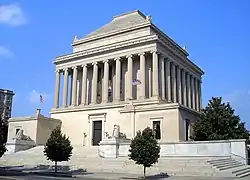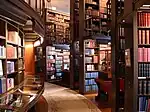House of the Temple
The House of the Temple is a Masonic temple in Washington, D.C., United States, that serves as the headquarters of the Scottish Rite of Freemasonry, Southern Jurisdiction, U.S.A. (officially, Home of The Supreme Council, 33°, Ancient & Accepted Scottish Rite of Freemasonry, Southern Jurisdiction, Washington D.C., U.S.A.)
| The House of the Temple | |
|---|---|
 House of the Temple in 2008 | |
 Location within Washington, D.C. | |
| General information | |
| Architectural style | American Neoclassicism |
| Address | 1733 16th St NW |
| Town or city | Washington, D.C. |
| Country | United States |
| Coordinates | 38.9138°N 77.0359°W |
| Construction started | October 18, 1911 |
| Completed | October 18, 1915 |
| Client | Scottish Rite of Freemasonry |
| Design and construction | |
| Architect(s) | John Russell Pope |
Designed by John Russell Pope, it stands at 1733 16th Street, N.W., in the Dupont Circle neighborhood, about one mile directly north of the White House. The full name of the Supreme Council is "The Supreme Council (Mother Council of the World) of the Inspectors General Knights Commander of the House of the Temple of Solomon of the Thirty-third degree of the Ancient and Accepted Scottish Rite of Freemasonry of the Southern Jurisdiction of the United States of America." It was modeled after the tomb of Mausolus at Halicarnassus.
It contains multiple museum rooms devoted to various subject matters which change on a rotating basis. The Temple also holds a permanent large collection of materials related to Scottish poet and Freemason Robert Burns, one of the world’s largest, in its library holdings, which Library was the first public library in Washington, D.C.[1]
History
On May 31, 1911, 110 years after the founding of the Supreme Council, Grand Commander James D. Richardson broke ground on the spot where the House of the Temple now stands in Washington, D.C. Grand Master J. Claude Keiper, of the Grand Lodge of the District of Columbia, laid the cornerstone in the northeast corner on October 18, 1911.[2]

The temple was designed by architect John Russell Pope, who modeled it after the tomb of Mausolus at Halicarnassus, one of the Seven Wonders of the Ancient World.[1] The building was dedicated four years later on October 18, 1915.
The building's design was widely praised by contemporary architects, and it won Pope the Gold Medal of the Architectural League of New York in 1917. In his 1920 book L'Architecture aux États-Unis, French architect Jacques Gréber described it as "a monument of remarkable sumptuousness ... the ensemble is an admirable study of antique architecture stamped with a powerful dignity." Fiske Kimball's 1928 book American Architecture describes it as "an example of the triumph of classical form in America". In the 1920s, a panel of architects named it "one of the three best public buildings" in the United States, along with the Nebraska State Capitol and the Pan American Union Building in Washington, D.C. In 1932, it was ranked as one of the ten top buildings in the country in a poll of federal government architects.[3]

In 1944, the remains of former Sovereign Grand Commander and Confederate General Albert Pike were removed from Oak Hill Cemetery in Georgetown and placed in the House of the Temple.[4] The remains of Past Grand Commander John Henry Cowles were entombed in the temple in 1952, after his 31-year reign as Grand Commander.[5] The Temple also holds one of the largest collections of materials related to Scottish poet and Freemason Robert Burns in its library. When the library opened in 1870, it was the first public library in Washington, D.C.[6]

The House of the Temple is designated as a contributing property to the Sixteenth Street Historic District, listed on the National Register of Historic Places in 1978.[7]
From 1990 to 2011, the temple hosted a community garden on its grounds. The Temple Garden occupied about 0.25-acre (1,000 m2), divided into about 70 small plots worked by nearby residents.[8] In fall 2011, the Temple closed the garden in order to use the space to stage construction equipment for a rehabilitation project.[9]
In popular culture
In the 2009 novel The Lost Symbol by Dan Brown, the building is the setting for several key scenes.[10]
See also
| Part of a series on |
| Freemasonry |
|---|
 |
- List of Masonic buildings
- List of museums in Washington, D.C.
- Masonic Temple (Washington, DC), a nearby building that was a Masonic temple from 1903 to 1983.
- Julius Lansburgh Furniture Co., Inc., an office building that was a Masonic temple from 1870 to 1921.
References
- Helwig, Anne H.; Ganschinietz, Suzanne (January 30, 1978). "National Register of Historic Places Inventory - Nomination Form". National Capital Planning Commission. (National Park Service). Archived from the original (PDF) on July 21, 2011. Retrieved February 28, 2010.
- Bell, Debra (January 6, 2010). "The Freemasons In Washington". U.S. News & World Report. Archived from the original on 2010-01-06. Retrieved September 11, 2020.
- House of the Temple Archived 2007-01-17 at the Wayback Machine, The Supreme Council, 33°, A.A. & S.R. of Freemasonry, S.J., USA website, accessed June 18, 2010
- Kelly, John (October 22, 2016). "Why is Confederate general Albert Pike memorialized at Judiciary Square?". The Washington Post. Retrieved September 26, 2020.
- Simpkins, Travis. "John Henry Cowles, 33°. Past Sovereign Grand Commander. Scottish Rite, SJ. by Travis Simpkins". Retrieved 2023-08-29.
- Fox, William L. (1997). Lodge of the Double-headed Eagle. University of Arkansas Press. p. 258. ISBN 9781610752435.
- "16th Street Historic District". National Park Service. Retrieved February 28, 2010.
- "Plot Map". The Temple Garden. Archived from the original on 2011-07-24. Retrieved 2010-09-16.
- Roso, Larissa (April 19, 2011). "Garden to Close for Masonic Temple renovation". The Washington Post. Retrieved 2012-08-24.
- Siegel, Robert (September 16, 2009). "Secret of the Masons: It's Not So Secret". All Things Considered. National Public Radio. Retrieved September 18, 2009.

